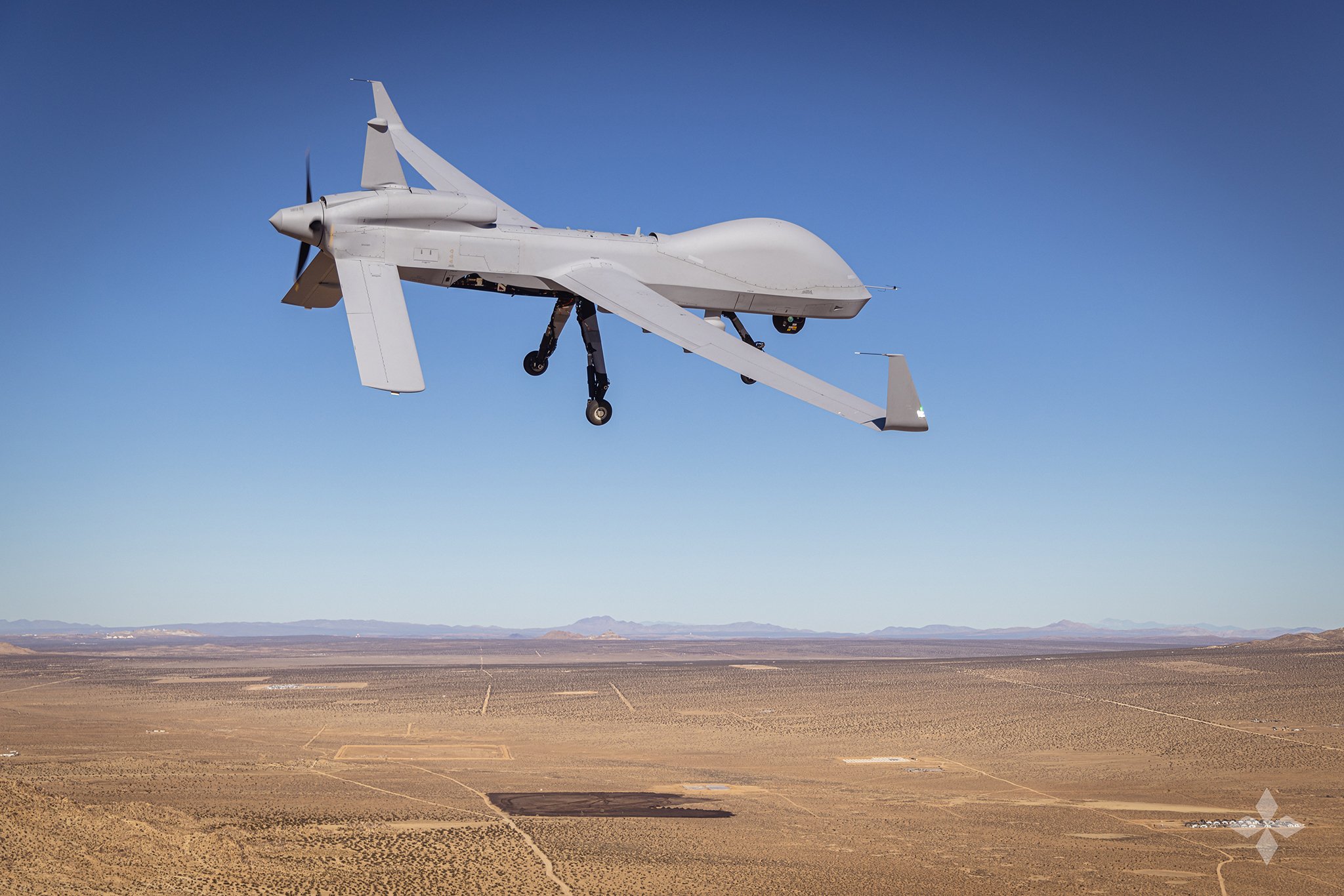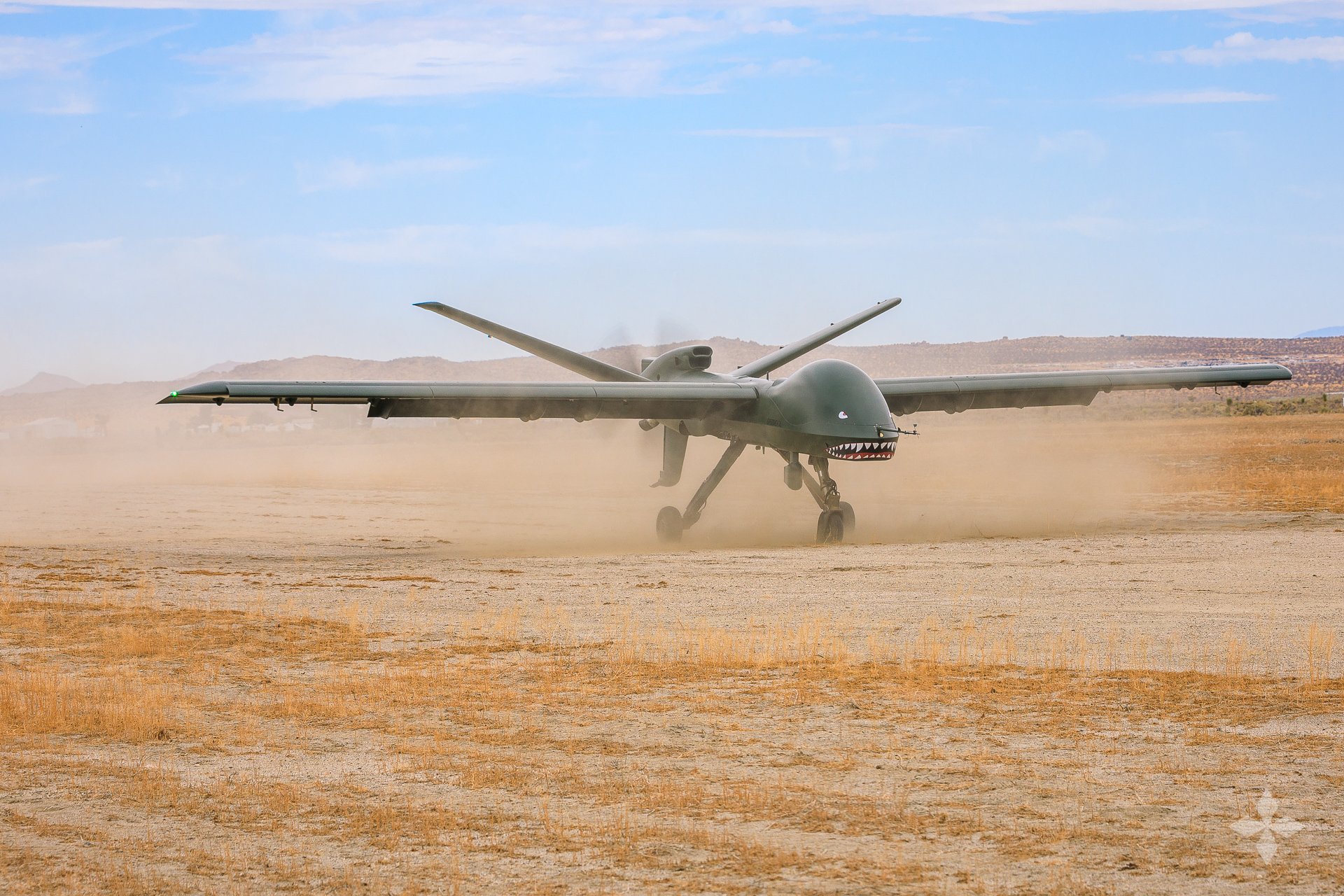
GA-ASI’s Gray Eagle 25M during its first flight at the company’s flight facility in El Mirage, California, on Dec. 5, 2023.
U.S. Army aviation has arrived at a detour on its journey toward modernization and staying ahead of tomorrow’s threats. The original path – the Future Attack Reconnaissance Aircraft program – is closed. So now what?
Fortunately, the Army is in a strong position to be able to pivot and redirect its efforts toward an advanced yet practical and affordable upgrade to aircraft it already owns: the Gray Eagle medium-altitude, long-endurance unmanned aircraft.
With more than 100 Gray Eagle Extended Range Aircraft already sitting in the arsenal, soldiers at every level are familiar with it – reducing risk, cost, training, and logistics challenges associated with a new program of record. Upgrading this proven and highly versatile system answers the Army’s need for multi-domain reconnaissance, surveillance, target acquisition, and other missions without the need for a clean-sheet design – and makes possible many other capabilities that only an unmanned system can offer.
The new-variant Gray Eagle 25M improves everything the Army already has. It reduces maintenance and operations hours. It adds significant ability to perform in contested environments with jam-resistant satellite communications, evolved data links, and navigation not reliant upon GPS. Gray Eagle 25M also comes with the new Heavy Fuel Engine, which increases time before overhaul and available power that lets the aircraft persevere through more severe weather and contested battlespace to provide over-the-horizon command and control with other systems.
These aircraft aren’t only premier reconnaissance, surveillance, target acquisition, and intelligence platforms; today’s 25M also is a truck for carrying launched effects, specialized payloads, and other battlefield effectors without putting personnel at risk in any phase of combat – whatever multi-domain forces need.
Already designated to carry the Army’s multifunction electronic warfare pod, recent employment in Europe with long-range synthetic aperture radar and intelligence-gathering systems showed that the Gray Eagle 25M can provide pre-conflict intelligence and targeting for long-range fires in the contest and complete phases of large-scale combat operations.
Greater onboard computing, power generation, and modular, open source architecture mean 25M can handle the processing and energy-intensive demands for payloads that enable counter-UAS and air defense artillery early warning for defensive operations. So not only can the aircraft serve as the launch platform for today’s launched effects such as the Army-supported aircraft called Eaglet – also made by the Gray Eagle’s builder, General Atomics Aeronautical Systems, Inc. – but the Gray Eagle 25M also has demonstrated it can serve as a trusted support system for new and different payloads, sensors, and launched effects from other manufacturers.
Gray Eagle STOL

GA-ASI’s Mojave unmanned aircraft system demonstrating short takeoff and landing on a dirt strip in El Mirage, California, on August 1, 2023.
Even as Gray Eagle 25M enables the Army to further leverage its current system in new ways, there’s another iteration also in development: a short takeoff and landing version of the aircraft known as Gray Eagle STOL.
This highly common aircraft flies with a modified wing and tail to greatly reduce its ground roll as compared with the current system. In exchange for some airborne endurance, STOL unlocks a huge new diversity of basing and operational concepts.
Gray Eagle STOL builds on the success of the record-setting General Atomics demonstrator known as Mojave, which has set aviation firsts for medium-altitude, long-endurance aircraft with its unimproved and dirt field performance, its naval warship flight operations at sea and, most recently, its first-of-their kind test sorties in which the aircraft destroyed a number of static targets with a pair of Dillon Aero miniguns.
Born from this rugged and proven pilot program, Gray Eagle STOL provides something no other system does: a full-featured, highly capable unmanned aircraft with runway independence and huge operational flexibility. Catapult, tube, or vertically launched UAS just cannot match its payload, mission endurance, range, and wealth of onboard capabilities.
Contested logistics
Among the many new mission options unlocked by Gray Eagle STOL is an answer to one of the Army’s toughest new challenges: contested logistics.
The battlefields of the future may not look like classical land power areas of engagement. Picture a forward line of troops behind which the Army controls rear areas as a means to supply U.S. and friendly forces. Tomorrow, complex new environments may look more like lily ponds with sections of allied control interspersed with contested areas – and technically adept prospective adversaries will try to deny safety anywhere.
This is what makes the new capabilities of Gray Eagle STOL, validated in several real-world situations by Mojave, so vital for the future force. Gray Eagle STOL’s ability to carry a 1,000-pound payload operationally relevant distances without the need for improved runways or ground support equipment – and no human crew on board – makes it ideal for contested logistics.
The aircraft’s onboard sensors give it the same ability to conduct surveillance, intelligence gathering, and other missions as a new Gray Eagle, but its STOL abilities mean it can take substantial amounts of cargo to forward units with no danger to a pilot. Expeditionary ground control systems mean Gray Eagle STOL can operate from a dirt strip, grass, remote highways, or even an athletic field complex for as long as needed.
Imagine an Army detachment fighting in a forward area, either a metaphorical island of allied control within contested territory – or on a literal island in a patch of ocean that was part of a larger conflict between sophisticated military powers.
Gray Eagle STOL takes off from a U.S. base with a load of ammunition, food, water, and other supplies for the forward troops. The aircraft also might carry air-to-ground munitions. Gray Eagle STOL flies to its drop-off point and circles to assess the conditions. If the area is safe, the aircraft lands on a straight stretch of beach, or on a neighborhood soccer field, and drops its cargo. The aircraft powers back into the air and resumes its orbit, providing armed overwatch as friendly ground forces pick up their food and supplies.
It isn’t science fiction. Gray Eagle STOL and Gray Eagle 25M are the best options for Army aviation as it assesses where to move from its current inflection point. The aircraft exist. They’re proven. They meet or exceed all the Army’s modular open systems architecture requirements, meaning any additional mission capabilities can be rapidly added or changed at the pace of technology.
The lowest risk and most powerful and adaptable option for the Army is to further leverage the Gray Eagles it already owns.





















